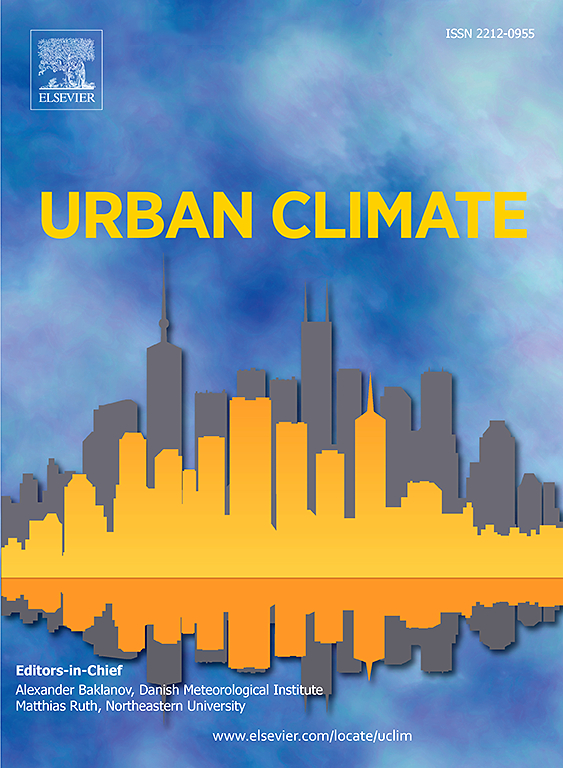Land-surface-physics-based downscaling versus conventional dynamical downscaling for high-resolution urban climate change information: The case study of two cities
IF 6.9
2区 工程技术
Q1 ENVIRONMENTAL SCIENCES
引用次数: 0
Abstract
This study for the first time examines the performance of the computationally-efficient land-surface-physics-based downscaling (LSP-DS) approach for high-resolution urban climate prediction by comparing it with the conventional dynamical downscaling (D-DS). LSP-DS utilizes the offline land-surface-modeling system HRLDAS, while D-DS employs the regional climate model WRF. Both approaches integrate the coupled land-surface and urban-canopy models. Simulations are driven by coarse-resolution reanalysis data to achieve 2-km climate downscaling, targeting two cities, Tokyo and Singapore. The findings reveal that LSP-DS can accurately reproduce the urban heat island (UHI) effect at high resolution, comparable with D-DS. LSP-DS even shows consistently better results for urban areas, across varying weather conditions such as heatwaves, non-heatwaves, dry, and rainy periods. Both methods show the same performance on the compound effects of heatwaves and UHI, with LSP-DS tending to simulate moderate UHI effects compared with D-DS. This study highlights the LSP-DS's potential as a computationally efficient and effective tool for urban climate downscaling, particularly to serve the next IPCC special report on climate change and cities. However, users should be mindful of the LSP-DS's limitations, such as the absence of two-way feedback with atmospheric physical and dynamical processes, when applying LSP-DS and explaining its results.
基于陆地表面物理的高分辨率城市气候变化信息降尺度与传统动态降尺度:两个城市的案例研究
本研究首次通过与传统的动态降尺度方法(D-DS)进行比较,研究了计算效率高的基于陆地表面物理的降尺度方法(LSP-DS)在高分辨率城市气候预测中的性能。LSP-DS采用脱机陆面模拟系统HRLDAS, D-DS采用区域气候模式WRF。这两种方法都整合了陆地表面和城市冠层的耦合模型。模拟由粗分辨率再分析数据驱动,以东京和新加坡两个城市为目标,实现2公里的气候降尺度。结果表明,LSP-DS能够准确再现城市热岛效应,且分辨率与D-DS相当。LSP-DS甚至在城市地区,在不同的天气条件下,如热浪、非热浪、干旱和雨季,都显示出一贯更好的结果。两种方法对热浪和热岛的复合效应的模拟结果相同,LSP-DS比D-DS更倾向于模拟中等热岛效应。这项研究强调了LSP-DS作为计算效率高且有效的城市气候降尺度工具的潜力,特别是为IPCC关于气候变化和城市的下一份特别报告服务。然而,在应用LSP-DS并解释其结果时,用户应该注意到LSP-DS的局限性,例如缺乏与大气物理和动力学过程的双向反馈。
本文章由计算机程序翻译,如有差异,请以英文原文为准。
求助全文
约1分钟内获得全文
求助全文
来源期刊

Urban Climate
Social Sciences-Urban Studies
CiteScore
9.70
自引率
9.40%
发文量
286
期刊介绍:
Urban Climate serves the scientific and decision making communities with the publication of research on theory, science and applications relevant to understanding urban climatic conditions and change in relation to their geography and to demographic, socioeconomic, institutional, technological and environmental dynamics and global change. Targeted towards both disciplinary and interdisciplinary audiences, this journal publishes original research papers, comprehensive review articles, book reviews, and short communications on topics including, but not limited to, the following:
Urban meteorology and climate[...]
Urban environmental pollution[...]
Adaptation to global change[...]
Urban economic and social issues[...]
Research Approaches[...]
 求助内容:
求助内容: 应助结果提醒方式:
应助结果提醒方式:


